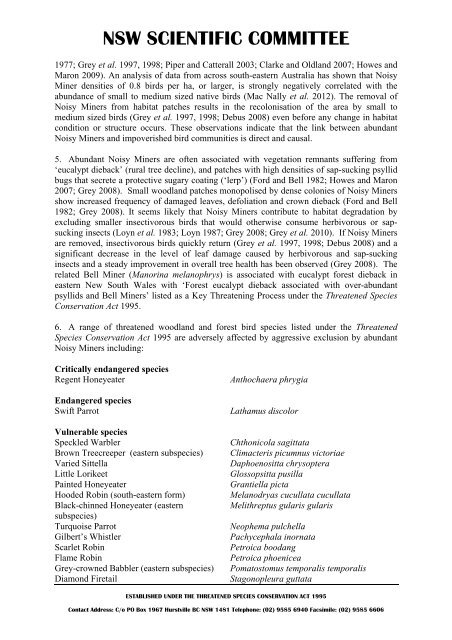Decline in woodland and forest birds due to aggressive exclusion by ...
Decline in woodland and forest birds due to aggressive exclusion by ...
Decline in woodland and forest birds due to aggressive exclusion by ...
You also want an ePaper? Increase the reach of your titles
YUMPU automatically turns print PDFs into web optimized ePapers that Google loves.
NSW SCIENTIFIC COMMITTEE<br />
1977; Grey et al. 1997, 1998; Piper <strong>and</strong> Catterall 2003; Clarke <strong>and</strong> Oldl<strong>and</strong> 2007; Howes <strong>and</strong><br />
Maron 2009). An analysis of data from across south-eastern Australia has shown that Noisy<br />
M<strong>in</strong>er densities of 0.8 <strong>birds</strong> per ha, or larger, is strongly negatively correlated with the<br />
abundance of small <strong>to</strong> medium sized native <strong>birds</strong> (Mac Nally et al. 2012). The removal of<br />
Noisy M<strong>in</strong>ers from habitat patches results <strong>in</strong> the recolonisation of the area <strong>by</strong> small <strong>to</strong><br />
medium sized <strong>birds</strong> (Grey et al. 1997, 1998; Debus 2008) even before any change <strong>in</strong> habitat<br />
condition or structure occurs. These observations <strong>in</strong>dicate that the l<strong>in</strong>k between abundant<br />
Noisy M<strong>in</strong>ers <strong>and</strong> impoverished bird communities is direct <strong>and</strong> causal.<br />
5. Abundant Noisy M<strong>in</strong>ers are often associated with vegetation remnants suffer<strong>in</strong>g from<br />
‘eucalypt dieback’ (rural tree decl<strong>in</strong>e), <strong>and</strong> patches with high densities of sap-suck<strong>in</strong>g psyllid<br />
bugs that secrete a protective sugary coat<strong>in</strong>g (‘lerp’) (Ford <strong>and</strong> Bell 1982; Howes <strong>and</strong> Maron<br />
2007; Grey 2008). Small <strong>woodl<strong>and</strong></strong> patches monopolised <strong>by</strong> dense colonies of Noisy M<strong>in</strong>ers<br />
show <strong>in</strong>creased frequency of damaged leaves, defoliation <strong>and</strong> crown dieback (Ford <strong>and</strong> Bell<br />
1982; Grey 2008). It seems likely that Noisy M<strong>in</strong>ers contribute <strong>to</strong> habitat degradation <strong>by</strong><br />
exclud<strong>in</strong>g smaller <strong>in</strong>sectivorous <strong>birds</strong> that would otherwise consume herbivorous or sapsuck<strong>in</strong>g<br />
<strong>in</strong>sects (Loyn et al. 1983; Loyn 1987; Grey 2008; Grey et al. 2010). If Noisy M<strong>in</strong>ers<br />
are removed, <strong>in</strong>sectivorous <strong>birds</strong> quickly return (Grey et al. 1997, 1998; Debus 2008) <strong>and</strong> a<br />
significant decrease <strong>in</strong> the level of leaf damage caused <strong>by</strong> herbivorous <strong>and</strong> sap-suck<strong>in</strong>g<br />
<strong>in</strong>sects <strong>and</strong> a steady improvement <strong>in</strong> overall tree health has been observed (Grey 2008). The<br />
related Bell M<strong>in</strong>er (Manor<strong>in</strong>a melanophrys) is associated with eucalypt <strong>forest</strong> dieback <strong>in</strong><br />
eastern New South Wales with ‘Forest eucalypt dieback associated with over-abundant<br />
psyllids <strong>and</strong> Bell M<strong>in</strong>ers’ listed as a Key Threaten<strong>in</strong>g Process under the Threatened Species<br />
Conservation Act 1995.<br />
6. A range of threatened <strong>woodl<strong>and</strong></strong> <strong>and</strong> <strong>forest</strong> bird species listed under the Threatened<br />
Species Conservation Act 1995 are adversely affected <strong>by</strong> <strong>aggressive</strong> <strong>exclusion</strong> <strong>by</strong> abundant<br />
Noisy M<strong>in</strong>ers <strong>in</strong>clud<strong>in</strong>g:<br />
Critically endangered species<br />
Regent Honeyeater<br />
Endangered species<br />
Swift Parrot<br />
Vulnerable species<br />
Speckled Warbler<br />
Brown Treecreeper (eastern subspecies)<br />
Varied Sittella<br />
Little Lorikeet<br />
Pa<strong>in</strong>ted Honeyeater<br />
Hooded Rob<strong>in</strong> (south-eastern form)<br />
Black-ch<strong>in</strong>ned Honeyeater (eastern<br />
subspecies)<br />
Turquoise Parrot<br />
Gilbert’s Whistler<br />
Scarlet Rob<strong>in</strong><br />
Flame Rob<strong>in</strong><br />
Grey-crowned Babbler (eastern subspecies)<br />
Diamond Firetail<br />
Anthochaera phrygia<br />
Lathamus discolor<br />
Chthonicola sagittata<br />
Climacteris picumnus vic<strong>to</strong>riae<br />
Daphoenositta chrysoptera<br />
Glossopsitta pusilla<br />
Grantiella picta<br />
Melanodryas cucullata cucullata<br />
Melithreptus gularis gularis<br />
Neophema pulchella<br />
Pachycephala <strong>in</strong>ornata<br />
Petroica boodang<br />
Petroica phoenicea<br />
Poma<strong>to</strong>s<strong>to</strong>mus temporalis temporalis<br />
Stagonopleura guttata<br />
ESTABLISHED UNDER THE THREATENED SPECIES CONSERVATION ACT 1995<br />
Contact Address: C/o PO Box 1967 Hurstville BC NSW 1481 Telephone: (02) 9585 6940 Facsimile: (02) 9585 6606
















